|
|
Ksar

|
|
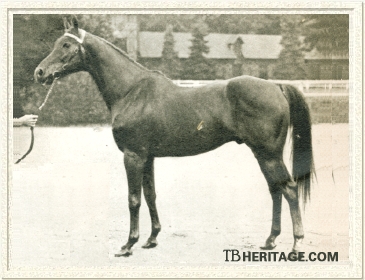 |
|
|
During World War I, the French Thoroughbred breeding industry suffered devastating losses, but some farms were able to continue to breed horses in relative tranquility from the battles raging on French soil. One such farm was Haras de Saint-Pair du Mont, near Calvados, in the Normandy region. It was owned by Evremond de Saint-Alary, who had been breeding champions and classic winners for approximately three decades before the start of the war. Saint-Alary bred two runners of the highest class in Kizil Kourgan, the best filly of her generation, and Brûleur, one of the best French-bred colts to appear on the tracks of France in the years immediately prior to the start of the war. By mating these two, Saint-Alary came up with Ksar, the best French runner to emerge right after the cessation of hostilities, and among the first to signal that French breeding was well able to recover from the devastation of the war.
Ksar was foaled in 1918. A striking chestnut with a lovely bloodlike head, Ksar had his faults. He was sickle-hocked and was once described as being "awkwardly put together with large clodhopper feet and poor action." Perhaps because he was so unprepossessing, Saint-Alary decided to put him up for sale at Deauville as a yearling in 1919. Despite his physical faults, the colt had a pedigree which made him, to say the least, extremely desirable.
Brûleur, his sire, was bred by Evremond de Saint-Alary and foaled in 1910. Saint-Alary had a fascination for the blood of Dollar a French-bred son of English Derby winner The Flying Dutchman, who had been exported to France in the 1850s. Dollar was noted for his stamina, and he successfully passed it on to his progeny and his descendants. Bruleur was inbred 5x4 to Dollar, as his dam, Basse Terre, was a descendant of Dollar in the direct male line. Chouberski, the sire of Bruleur, had been a winner of his only start, but had to recommend him as a stallion the fact he was a son of Gardefeu, a winner of the Prix du Jockey Club and Prix du Conseil Municipal and a great-grandson of Dollar.
The dam of Brûleur, Basse Terre, was a stakes performer of high class, but enjoyed more success in the breeding shed. Her daughter Basse Point, three years older than Bruleur, had captured such important fixtures as the Prix du Conseil Municipal, Prix Vermeille, and Grand Prix de Deauville.
Brûleur proved to be a stayer of the highest class, his victories including the Grand Prix de Paris and Prix Royal-Oak. Ksar was his first top class representative in a long stud career which saw him sire a total of six classic winners, including four winners of the Prix du Jockey Club, three winners of the Prix de l'Arc de Triomphe, two winners of the Prix Royal-Oak, four winners of the Prix du Cadran, and one each of the Grand Prix de Paris and English Oaks.
|
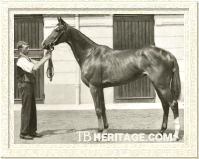
His dam, Kizil Kourgan
| |
The dam of Ksar was Kizil Kourgan, a foal of 1899 and the best filly of her generation in France. She was a daughter of the stout French classic winner Omnuim II, winner of the Prix du Jockey Club, Prix du Cadran, and two editions of the Prix du Conseil Municipal. Her dam, Kasbah, had placed second in the Poule d'Essai des Pouliches, France's version of the One Thousand Guineas. Kizil Kourgan had the speed of her dam and the stoutness of her sire all wrapped in one beautiful, athletic chestnut package. As a three-year-old, she blazed through a magnificent season in which she captured the Poule d'Essai des Pouliches, the Prix Lupin over colts, the Prix de Diane, the Grand Prix de Paris, and the prix Royal-Oak before she finally met defeat in the late part of the year. In the Grand Prix, one of those she vanquished was England's brilliant filly Sceptre, winner that season of the One Thousand and Two Thousand Guineas, the Oaks, and who would later that autumn, take the St. Leger.
|
Kizil Kourgan had a disappointing career as a broodmare, producing nothing except some minor winners prior to the arrival of Ksar. She was an aged nineteen when he was foaled. Her subpar produce record may have been another reason Saint-Alary decided to sell her yearling colt by Brûleur. Nevertheless, Ksar was knocked down for the remarkable price of 151,000 francs to another French breeder of some renown, Edmond Blanc, master of Haras de Jardy and the man who had paid an astonishing £37,000 for English Triple crown champion Flying Fox at the dispersal sale of the late Duke of Westminster in 1900. Flying Fox turned out to be worth every penny, becoming a highly successful sire in France. When asked why he had paid so much for the homely Ksar, Blanc replied, "Yes, he is ugly, but he is ugly in exactly the same way as Omnium II. Besides, he is a beautiful walker!" Unfortunately, Blanc did not live to see Ksar reward his faith, for he died in 1920 at the age of 66. Ksar raced for Madame Blanc.
Ksar on the Turf
Ksar was precocious in his early training and ready to run as a juvenile, a rare occurrence for the get of Brûleur. So highly was Ksar thought of, he made his debut in the important Prix de la Salamamdre, run over seven furlongs. Ridden by veteran jockey George Stern, Ksar won smartly by a head from the favorite Petsik. In his only other race that season, Ksar lost by half a length to Soldat II in the Prix Saint Roman, run on the Prix de l'Arc de Triomphe undercard.
|
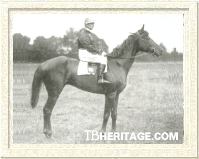
Ksar on the Turf
| |
Ksar learned his lessons well, for at three, he was nearly invincible. His seasonal debut took place in the 1-1/2 mile Prix Hocquart, which he took by three lengths from Tacite, the favorite. After the race, jockey Stern remarked in a masterfully understated way of Ksar, "This is an exceptional horse." Next, in the 1-3/8 mile Prix Lupin, Ksar defeated Tacite by less than a length. It set the colt up well for the Prix du Jockey Club at Chantilly on June 12, 1921. Partnered by Frank Bullock, as Stern was committed to Marcel Boussac's entrant Grazing, Ksar won by a length and a half from Grazing. |
A fortnight later, Ksar was an overwhelming favorite for the Grand Prix de Paris. Over hard ground not suited to his feet and after three hard races, Ksar ran an uncharacteristically poor race to finish fourth to the English invader Lemonora.
Rested until September, Ksar redeemed himself with a scintillating victory in the Prix Royal-Oak, leaving in his wake Flechois and Harpocrate, who had both finished in front of him in the Grand Prix, as well as Tacite and Grazing. In fact, so little did his win in the Prix Royal-Oak take out of Ksar, he was brought out again three weeks later for the Prix de l'Arc de Triomphe and, again partnered by Stern, won as he liked by two lengths. A week and a half later, Ksar dead-heated for first with Vatel in the Prix Edgard Gillois, and was then retired for the season.
He was not seen under colors again until April 2, in the Prix des Sablons, a 1-1/4 mile prep for the prestigious Prix du Cadran. With Frank Bullock up, Ksar had an easy time of it and won convincingly. The Prix du Cadran, run over twice the distance of the Prix des Sablons, at 2-1/2 miles, was France's version of England's historic Ascot Gold Cup. Ksar had no trouble either staying the marathon distance, or in defeating Flechois and Harpocrate by a length.
Sent out next at Saint-Cloud for the Prix du Président de la République, Ksar suffered a surprise defeat. Ridden for the first time by English jockey Joe Childs, Ksar came storming furiously, but just missed by a head to Kircubbin. The defeat was blamed on Childs, who was accused of keeping Ksar too far back and not allowing him to make his run until it was too late.
Redemption came in his next two starts, victories in the Prix du Prince d'Orange and a second Prix de l'Arc de Triomphe. In the latter race, Ksar defeated both that year's Prix du Jockey Club winner, Ramus, and Kefalin, winner that season of the Grand Prix de Paris.
Ksar closed out his racing career on a note of anticlimax. In the 3-7/8 mile Prix Gladiateur, Ksar lost by two lengths over a heavy, tiring track to Flechois, who was a good horse, for also in his career, he took the Prix du Conseil Municipal, but he was nowhere near the extreme class of Ksar.
Ksar left the track with eleven victories in fifteen starts, and 1,634,775 francs in earnings. This was the equivalent to over $250,000, making him at the time, the world's leading money earner, and the first horse whose parents had also earned the equivalent of over $100,000. He was sent to stud at Madame Blanc's Haras de Jardy, Edmond Blanc's widow running the farm for many years after her husband's death. There, Ksar became a formidable rival to his own sire in the breeding ranks. He led the French general sires list once, in 1931.
|
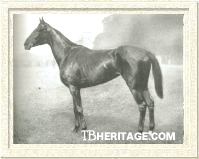
Ukrania
| |
The first of Ksar's classic winners came in his third crop, foals born in 1926. This was the bay filly UKRANIA. Ksar's book of mares was replete with quality, as shown by UKRANIA'S dam, Uganda. A daughter of Bridaine, Uganda had taken the Prix de Diane, Prix Royal-Oak, and Prix la Rochette. Like her dam, Ukrania was victorious in the Prix de Diane. Sadly, she failed to live up to expectations as a broodmare, but her dam later produced English Oaks winner Udaipur and her full brother Umidwar, winner of the Champion and Jockey Club Stakes. |
Ksar's next crop contained two exceptional performers--AMFORTAS and DIADEME. The former, out of the Teddy mare Persephone, went on to take the Prix d'Harcourt, Prix des Sablons and run second in the Prix de l'Arc de Triomphe. He made a good sire, coming up with such major winners as One I Love, Nuageux, and Clodoche. AMFORTAS was also the broodmare sire of English Derby and Grand Prix de Paris winner My Love and Prix de Diane winner Aglae Grace.
DIADEME, out of Durban, by Durbar II, was bred by Marcel Boussac. She was a winner in her career of the Prix Penelope and Newmarket Oaks, and ancestress of dual French classic winner Caravelle and multiple French stakes winner Cordova.
|
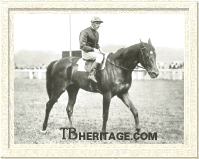
Tourbillon
| |
The next mating between Ksar and Durban resulted in Ksar's most important offspring, both from racing and breeding standpoints. This was TOURBILLON, foaled in 1928. Tourbillon was bred and raced by Marcel Boussac and retained by him for stud purposes. On the racecourse, Tourbillon won half of his twelve starts, including the Prix du Jockey Club, Prix Hocquart, Prix Lupin, the Prix Greffulhe, the Prix de Vineuil at Chantilly, and the Zukunfts-Rennen at Baden-Baden in Germany. He did not possess the staying ability of his sire or grandsire, as witnessed by losing efforts in the Prix Royal-Oak, Prix du Président de la République, and Grand Prix de Paris. He broke down during the running of the Prix de l'Arc de Triomphe and was retired to stud at the end of his three-year-old season.
|
At stud, TOURBILLON became one of the most prolific and important sires of his era. He was champion sire in France three times, in 1940, 1942, and 1945. His progeny included Djebel, a champion in France, winner of the English Two Thousand Guineas and Prix de l'Arc de Triomphe, and a major sire in his own right; Caracalla, an unbeaten champion whose victories included the Arc de Triomphe, Grand Prix de Paris, and Ascot Gold Cup; Ambiorix, a champion and France and later a very successful sire in the United States; champion filly and French classic winner Esmeralda; Cillas and Coaraze, both winners of the Prix du Jockey Club; Tourment, a versatile winner of the one mile Poule d'Essai des Poulains and the Prix Royal-Oak; and Goya, a champion France, multiple stakes winner in England and later imported to the united States for stud duty.
Daughters of TOURBILLON produced French classic winners Coronation, Auriban, and Palencia, as well as Corejada, a champion at both two and three in England, winner of the Cheveley park Stakes, Irish Oaks, and Poule d'Essai des Pouliches. Tourbillon was humanely put down at the age of 26 following a stroke in the summer of 1954.
|
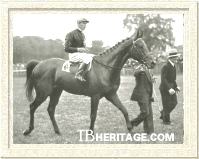
Thor
| |
In the crop of 1930 came THOR. Named for the god of thunder in Norse mythology, THOR more than lived up to his name, for he was as thunderous in personality for a horse as it was possible to be. He carried all of the ill temper of his grandsire Brûleur, and then some. His dam was Lasarte, by Alcantara, and his second dam was by Gardefeu, giving Thor a 4 x 3 inbreeding to that stallion. In addition, Thor carried two crosses of the fiery blood of Galopin. He won the Prix du Jockey Club and Prix du Cadran, and placed in the Grand Prix de Paris and Ascot Gold Cup.
|
THOR did well as a sire, coming up with French stakes winner Imperator; Tariel, a successful sire in Belgium; and Kasdagh, winner of the Polish Oaks. As a broodmare sire he was represented by Djelfa, winner of the Poule d'Essai des Pouliches and Ambicao, winner of the Brazilian classic Grande Premio Diana.
During World War II, THOR was seized by the Germans, and reportedly killed two soldiers in the process. After the war, he was sold to the English National Stud, where, after severely mauling a groom, he was humanely destroyed.
Ksar's last classic winner was LE KSAR, foaled in 1934 and out of Teddy's daughter Queen Iseult. His major victory came in the English Two Thousand Guineas. Le Ksar was sold for stud duty to Argentina, where he had a moderately successful career.
|
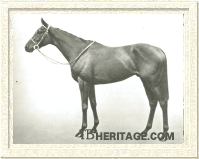
Ut Majeur
| |
UT MAJEUR (1927, from Uganda, and so UKRANIA'S brother) was purchased by the Aga Khan and started his racing career at age three, when he ran 21 times. He won five races (including a dead-heat), ran second five times, including the Newmarket and Jockey Club Stakes, and was third three times, including the Ascot and Goodwood Cups, and did not place eight times. His big wins were an easy triumph, by four lengths, in the Cesarewitch at age three, carrying 8 st-3 lb, a heavy weight for younger horses in that race, and the Newmarket St. Leger where he beat seven others by four lengths. He ran without distinction for two more years, and was retired to stand at First Flier Stud at Pollardstown, near the Curragh (Ireland). He was later sent to stud in Hungary and Russia.
|
Ksar's son FORMOR (1934, from Bertina by La Farina) got the Cheltenham Gold Cup winner Fortina. Fortina was later a superior sire of steeplechasers and hurdlers, getting four winners of the Irish Grand National, the two excellent Cheltenham Gold Cup winners, Fort Leney and Glencaraig Lady, and the top U.S. chasers Bampton Castle (American Grand National, twice) and Fort Devon (Maryland Hunt Cup).
As a broodmare sire, daughters of Ksar produced winners not only in France and England, but also in Spain, Australia, Argentina, and Brazil. Ksar's stakes-winning daughter, ADVERTENCIA, became the dam of Le Pacha, foaled in 1938. Le Pacha was a winner of nine races, and as a three-year-old in 1941, was unbeaten, taking the Prix du Jockey Club, Prix Royal-Oak, Grand Prix de Paris, and Prix de l'Arc de Triomphe. He was retired to Haras de Saint-Crespin par le Mesnil Mauger near Calvados, France, becoming a useful sire of winners. An older full brother to Le Pacha was Labrador, winner of the Prix l'Esperance. A half-sister to both Labrador and Le Pacha was Vertencia, winner in England of the important Park Hill Stakes at Doncaster.
STEP ALONG, from Ksar's 1932 crop, became the dam of Prix de Diane victress Stratonice, who also placed third in the Irish Oaks. YENNA, foaled in 1927, was a winner of one race. At stud, she produced two classic champions in English Two Thousand Guineas winner Kingsway and Poule d'Essai des Pouliches heroine Yonne.
Basileus, champion French three-year-old of 1945, was a son of Ksar's daughter BARBERYBUSH, a winner on the track of the Prix de Malleret. His victories included the Prix du Conseil Municipal, Grand Prix de Deauville, Prix des Sablons, and second place finishes in the Prix du Jockey Club, Prix Royal-Oak, and Prix du Cadran. Exported to the United States, Basileus captured the Southern Maryland Handicap and placed third in the Bowie Handicap. The stud career of Basileus was mediocre, for he sired only minor stakes winners and some winners over jumps. A full sister to Basileus, Bergeronnette, was also a stakes winner in France, as was half-sister Blue-Berry. BARBERYBUSH was second dam of Neptunus, winner of the Poule d'Essai des Poulains and Grand Criterium, and second dam of Right Royal, whose resume included victories in the Prix de la Salamandre, Grand Criterium, Poule d'Essai des Poulains, and Prix du Jockey Club in France, and the King George VI and Queen Elizabeth Stakes in England.
San Domenico, a champion sprinter in Australia, and Garbosa Bruleur, a champion filly in Brazil, were each produced from Ksar mares. MARAVILLA was a daughter of Ksar who wound up in Spain, where she produced Sandra, winner in 1946 of the Premio Cimera at Madrid, which was Spain's equivalent to the Two Thousand Guineas.
MEDEE, a member of Ksar's first foal crop, was a half-sister to La Flambee, who became ancestress of the superior American performers Omaha, Flares, Gallorette. Medee was exported to Argentina, becoming the dam of a colt by Congreve named Medicis. He was champion three-year-old colt in Argentina in 1936 by virtue of victories in the Gran Premio Jockey Club and Gran Premio Polla de Potrillos. In all, he won nine of twelve races.
In 1935, at the age of seventeen, Ksar was sold to Abram S. Hewitt, an American breeder and racing authority and exported to stand stud at Hewitt's Montana Hall Stud near Millwood, Virginia. The old stallion had a rough ocean crossing, falling critically ill on the journey. In Virginia, he sired just two crops, but got nothing of the class he got in France. Ksar, did, though, exert an influence in jumping pedigrees, and several international show jumpers carried his blood in their veins.
In France, a winner of the Grand Steeple-Chase de Paris was Hahnhof, produced from a daughter of Ksar. In the states, Ksar daughters produced steeplechase stakes winners Quiet and Pontius Pilate. The 1960 summer Olympic Games in Rome saw the Grand Prix jumping team from the United States take the silver medal. One of the horses on that team, ridden by William Steinkras, was Ksar d'Espirit, again out of a daughter of Ksar.
Ksar died in September, 1937, aged nineteen, at Montana Hall from an internal hemorrhage. He was buried at the farm, where a monument to the great French ex-patriate was erected over his grave.
--Elizabeth Martiniak
|
|
|
|

